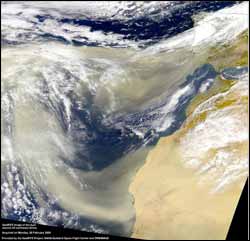Saharan Dust Affects Thunderstorm Behavior in Florida

Saharan Dust Blowing off Northwest Africa: This is an image of dust storms taken by NASA’s SeaWiFS satellite, taken on Feb. 28, 2000. Click on image to enlarge. Credit: NASA
People that live in Florida would expect the sands from the state beaches to blow into the air, and usually don’t think of the sands and dust from the Saharan Desert twirling around them. However, winds do carry the desert dust across the Atlantic Ocean, and scientists have been studying what they do to Florida Thunderstorms.
Scientists have discovered that these tiny particles of dust from the Saharan desert can affect thunderstorms in Florida in various ways. Dust affects the size of a thunderstorm’s “anvil” or top, the strength and number of warm updrafts (rising air), and the amount of rain that builds up and falls from the “heat generated” or convective thunderstorms.
Findings on the “Impact of Saharan Dust on Florida Storm Characteristics” were presented at the 2005 annual meeting of the American Meteorological Society on Jan. 11 at the San Diego Convention Center in San Diego, Calif. Susan C. van den Heever, Gustavo G. Carrio, William R. Cotton, Paul. J. DeMott and Anthony J. Prenni, all of Colorado State University, Fort Collins, Colo. co-authored a study which will appear in a forthcoming issue of the Journal of Atmospheric Sciences.
Working with her colleagues, van den Heever found that when Saharan dust is in the air, the thunderstorm anvils created by Florida’s convective thunderstorms tend to be a little smaller in area, but they tend to be better organized and thicker. This affects the amount of incoming sunlight and warmth reaching the ground, which can have effects on long-term climate. Over time, more sunlight would warm temperatures, less sunlight would cool temperatures.
The researchers also noticed that the updrafts of warm moist air, which build into thunderstorms, were stronger, and that there were more of these updrafts produced in the presence of the dust. These updrafts also carry tiny particles of pollution called aerosols up into all levels of the building thunderclouds.
Florida residents not only see more updrafts developing during dust events, but the dust affects the amount of rainfall that reaches the ground. Dust is an aerosol, and aerosols or little particles serve as the center or nuclei (called a cloud condensation nuclei) for cloud droplets to form around. These cloud droplets then combine to form raindrops which fall to the ground. As such, aerosols affect the production of rainfall.
There are three types of nuclei that Saharan dust can be. They can act as the center or nuclei for water vapor as a CCN, GCCN (Giant Cloud Condensation Nuclei) and IN (Ice Nuclei), where ice forms around a dust particle center. Van den Heever used a computer model to see how the atmosphere and clouds react with Saharan dust and without the desert dust. She then compared the results and found something unusual. The dust increased the number of centers or nuclei for raindrops and decreased the amount of rainfall at the Earth’s surface.
Nuclei or centers for droplets in a cloud compete for a limited amount of water vapor and liquid water to form raindrops. When there are many particles that act as a center for water vapor, there is less water for each center, resulting in smaller cloud droplets. As such, it is less likely that raindrops will form when droplets combine.
the stratosphere. Click on image to enlarge. Credit: NASA
The scientists also found that greater concentrations of Giant CCN (GCCN) as well as ice nuclei initially resulted in more rainfall reaching the surface. However, as the storms continued to develop, the two types of nuclei were removed from the storms by the precipitation and these nuclei then had less of an effect on the amount of rain reaching the surface. The scientists concluded that the overall effect of the Saharan dust on the surface rainfall was to reduce it.
The scientists used data from NASA’s CRYSTAL-FACE (Cirrus Regional Study of Tropical Anvils and Cirrus Layers – Florida Area Cirrus Experiment) field campaign to examine the affects of increased numbers of nuclei from the dust and pollutants. The purpose of the CRYSTAL-FACE mission was to study cirrus clouds to improve forecasts of future climate change.
The scientists concluded that Saharan dust can have a major impact on the amount of rainfall produced by thunderstorms in Florida. Also, because dust affects the size and thickness of thunderstorm anvils, the changes affect the amount of sunlight reaching Earth and being reflected by the clouds, which have implications for a changing climate. Finally, this research can also help answer questions about how tiny particles called aerosols and other pollutants move around the world in the upper atmosphere.
Media Contact
All latest news from the category: Earth Sciences
Earth Sciences (also referred to as Geosciences), which deals with basic issues surrounding our planet, plays a vital role in the area of energy and raw materials supply.
Earth Sciences comprises subjects such as geology, geography, geological informatics, paleontology, mineralogy, petrography, crystallography, geophysics, geodesy, glaciology, cartography, photogrammetry, meteorology and seismology, early-warning systems, earthquake research and polar research.
Newest articles

Magnetic Effect: Groundbreaking Discovery for Low-Temperature Thermoelectric Cooling
Researchers at the Max Planck Institute for Chemical Physics of Solids, in collaboration with Chongqing University and the Max Planck Institute of Microstructure Physics, have achieved a breakthrough in topological…

Parallel Paths: Understanding Malaria Resistance in Chimpanzees and Humans
The closest relatives of humans adapt genetically to habitats and infections Survival of the Fittest: Genetic Adaptations Uncovered in Chimpanzees Görlitz, 10.01.2025. Chimpanzees have genetic adaptations that help them survive…

You are What You Eat—Stanford Study Links Fiber to Anti-Cancer Gene Modulation
The Fiber Gap: A Growing Concern in American Diets Fiber is well known to be an important part of a healthy diet, yet less than 10% of Americans eat the minimum recommended…



